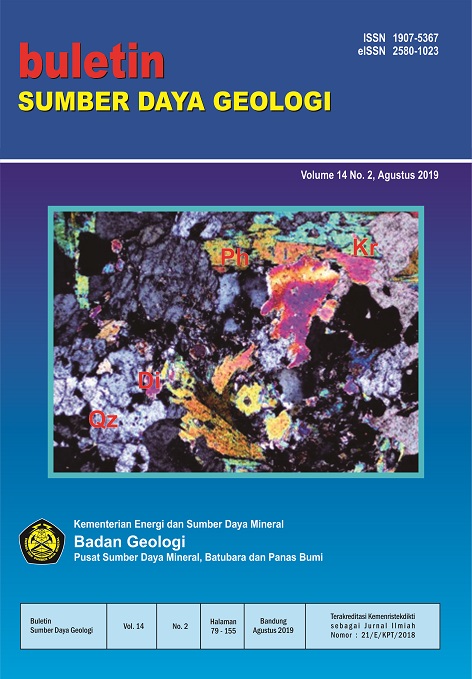APPLIED GEOSTATISTICS TO THE ASSESSMENT OF ENHANCED GEOTHERMAL SYSTEM (EGS) IN CENTRAL SUMATERA BASIN
Abstract
Thick sediment (over 2,500 m), fractured basement and high thermal gradient (up to 19.10 C/100 m) of Central Sumatra Basin are suitable factors to have the Enhanced Geothermal System (EGS) potential. A number of 130 wells data were used to evaluate the EGS of the basin. The assessment is divided into the number of estimation within the grid cell (1x1 km) of sediment thickness, heat flow, thermal conductivity and technical potential calculated starting from basement-sediment layer interface. The distribution of heat flow and gradient thermal values correspond to the sediment layer. The autocorrelation test indicates the data is stationary. The variance of data gets bigger after a depth over 5.5 km. According to the Beardsmore protocol, the technical potential value ranged from 0.5 MW up to 4.7 MW at a depth of 3.5 km. In addition, the lowest technical potential is 0.66 MW and the highest is 5.76 MW at a depth of 4.5 km. The ordinary kriging, using the number of lags 10 in variogram modeling, estimated the technical potential distribution is higher to the southwest.
Downloads
References
Pambudi, N.A., 2017. Geothermal power generation in Indonesia, a country within the ring of fire: Current status, future development and policy. Renewable and Sustainable Energy Reviews. 81, p. 2893-2901.
Limberger, J., Calcagno, P., Manzella, A., Trumpy, E., Boxem, T., Pluymaekers, M.P.D. and van Wees, J.D., 2014. Assessing the prospective resource base for enhanced geothermal systems in Europe. Geothermal Energy Science. 2(1). p. 55.
Tester, J. W., Anderson, B. J., Batchelor, A. S., Blackwell, D. D., DiPippo, R., Drake, E., ... and Petty, S., 2006. The future of geothermal energy: Impact of enhanced geothermal systems (EGS) on the United States in the 21st century. Massachusetts Institute of Technology, p. 209.
Hendrawan, R.N. and Draniswari, W.A., 2016. Assessing the possibility of Enhanced Geothermal System in western Indonesia. IOP Conference Series: Earth and Environmental Science. Sci. 42. 012021.
Beardsmore, G.R., Rybach, L., Blackwell, D. and Baron, C., 2010. A protocol for estimating and mapping global EGS potential. GRC Transactions. 34. p. 301-312.
Busby, J. and Terrington, R., 2017. Assessment of the resource base for engineered geothermal systems in Great Britain. Geothermal Energy. 5(1). p. 7.
Rybach, L., 2010. The future of geothermal energy and its challenges. Proceedings World Geothermal Congress Bali 2010, 29, p. 4.
Van Wees, J., Boxe, T., Angeloni, L., and Duas, P., 2013. A Prospective Study on the Geothermal Potential in the EU. Geoelect Report.
Eubank, R.T. and Makki, A.C., 1981. Structural Geology of the Central Sumatra Back-arc Basin. Indonesian Petroleum Association, Proceeding 10th Annual Convention, p. 153-196.
Heidrick, T.L. and Aulia, K., 1993. A structural and Tectonic Model of The Coastal Plain Block, Central Sumatera Basin, Indonesia. Indonesian Petroleum Association, Proceeding 22th Annual Convention, 1, p. 285-316.
Clauser, C., 2006. Geothermal energy. Landolt-Börnstein, group VIII: advanced materials and technologies, 3, p. 493-604.
Slagstad, T., 2008. Radiogenic heat production of Archaean to Permian geological provinces in Norway. Norwegian Journal of Geology, 88, p. 149-166.
Curran, P. J., 1988. The Semivariogram in Remote Sensing: An Introduction. Remote Sensing of Environment. 24(3). p. 493-507.
Lee, C. F., Lee, J. C., and Lee, A. C., 2000. Statistics for business and financial economics. World Scientific. 1. Singapore. p. 712.
Copyright (c) 2019 Buletin Sumber Daya Geologi

This work is licensed under a Creative Commons Attribution-NonCommercial-ShareAlike 4.0 International License.
Authors whose manuscripts are published agree to the following terms:
The publication rights of all journal manuscript materials published on the Buletin Sumber Daya Geologi website are held by the editorial board with the knowledge of the author (moral rights remain with the manuscript’s author).
The formal legal provisions for access to digital articles in this electronic journal are subject to the terms of the Creative Commons Attribution-ShareAlike (CC BY-SA) license. This means that Buletin Sumber Daya Geologi has the right to store, convert media/formats, manage in the form of a database, maintain, and publish the article without requesting permission from the author, as long as the author’s name is cited as the copyright holder.
Manuscripts published in both print and electronic formats are open access for educational, research, investigative, and library purposes. Beyond these purposes, the editorial board is not responsible for any violations of copyright law.















